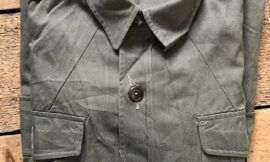The M1 Carbine is a lightweight, semi-automatic carbine developed in the United States during World War II. Known for its portability, ease of use, and adequate firepower, the M1 Carbine served various roles across multiple conflicts and remains an iconic firearm in military history.
Historical Background
The development of the M1 Carbine began in 1940 when the U.S. Army sought a new, lightweight firearm to provide support troops and other personnel with a weapon more powerful than a handgun but lighter and easier to handle than the M1 Garand rifle. The carbine was intended to replace the M1911 pistol and to arm paratroopers, engineers, and other troops whose primary duties did not involve frontline combat but who still needed an effective self-defense weapon.
The design competition was won by Winchester Repeating Arms Company, led by David Marshall Williams, who contributed significantly to the carbine’s development. The M1 Carbine was officially adopted in 1941 and saw extensive use throughout World War II, Korea, and even the early stages of the Vietnam War.
Design and Features
The M1 Carbine boasts several distinctive design features:
- Lightweight and Compact: Weighing about 5.2 pounds (2.36 kg) and measuring 35.6 inches (900 mm) in length, the M1 Carbine is significantly lighter and more compact than the M1 Garand, making it easier to carry and handle.
- Semi-Automatic Operation: The M1 Carbine is a gas-operated, semi-automatic firearm. This mechanism allows for a faster rate of fire compared to bolt-action rifles.
- Caliber and Ammunition: The carbine fires the .30 Carbine cartridge, which, while less powerful than the .30-06 Springfield round used by the M1 Garand, offers sufficient stopping power at typical combat ranges.
- Magazine Feed: The M1 Carbine is fed from detachable box magazines, typically holding 15 rounds. Later models and accessories allowed for the use of 30-round magazines.
- Sights: The carbine is equipped with adjustable iron sights, providing reasonable accuracy at ranges up to 300 yards (270 meters).
- Ergonomics: The stock and overall design of the M1 Carbine provide good ergonomics, allowing for ease of use and quick target acquisition.
Variants
Several variants of the M1 Carbine were developed to fulfill different roles and operational requirements:
- M1A1: This variant featured a folding metal stock and was designed for paratroopers. The compact design made it easier to carry and deploy after parachuting.
- M2 Carbine: Introduced towards the end of World War II, the M2 was a selective-fire version capable of both semi-automatic and fully automatic fire. It featured a heavier stock to handle the increased recoil.
- M3 Carbine: The M3 variant was fitted with an infrared scope for use as a night-fighting weapon. It was one of the first practical night vision devices used in combat.
- Commercial and Post-War Variants: After the war, various civilian versions were produced for hunting, sport shooting, and law enforcement. Companies like Universal Firearms and Inland Manufacturing produced commercial models.
Military Use
The M1 Carbine was widely used by U.S. and allied forces during several major conflicts:
- World War II: Issued to support troops, officers, and paratroopers, the M1 Carbine proved effective in various theaters of the war. Its lightweight and compact design were especially appreciated in the Pacific, where dense jungles made larger rifles cumbersome.
- Korean War: The M1 and M2 Carbines saw extensive use during the Korean War. However, the carbine’s performance in extremely cold weather sometimes led to criticisms of its stopping power.
- Vietnam War: The M1 Carbine was used by South Vietnamese forces and some U.S. troops during the early stages of the Vietnam War. Its light weight and ease of handling were advantageous in jungle warfare.
- Post-War Service: The M1 Carbine continued to serve in various capacities with military, police, and paramilitary forces worldwide, from Europe to Asia to the Middle East.
Performance
The M1 Carbine is noted for its balance of portability, ease of use, and sufficient firepower. Its performance characteristics include:
- Accuracy: Effective at ranges up to 200-300 yards, the carbine provides adequate accuracy for its intended role.
- Firepower: While the .30 Carbine round is less powerful than rifle cartridges, it offers more stopping power than standard pistol rounds, making it effective in close to medium-range combat.
- Reliability: The M1 Carbine is generally reliable, though early models experienced some issues with jamming. Later modifications improved its performance.
Conclusion
The M1 Carbine stands out as a significant development in military small arms, providing a versatile and effective solution to the need for a lightweight, portable firearm. Its extensive use in multiple conflicts and continued presence in various military and civilian roles underscore its lasting impact and importance. The M1 Carbine remains a celebrated piece of military history and a testament to the innovative design and practical engineering of its time.


